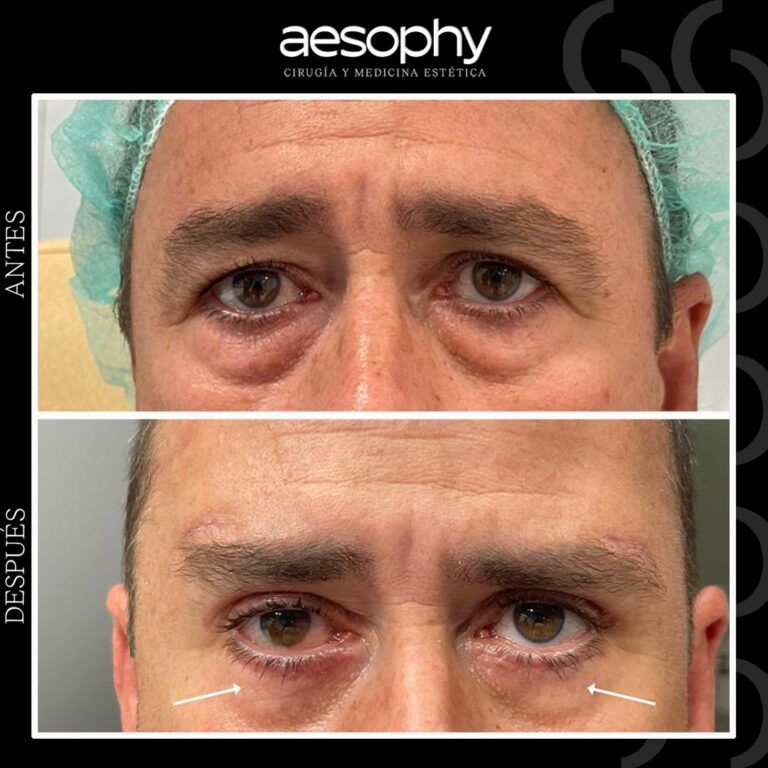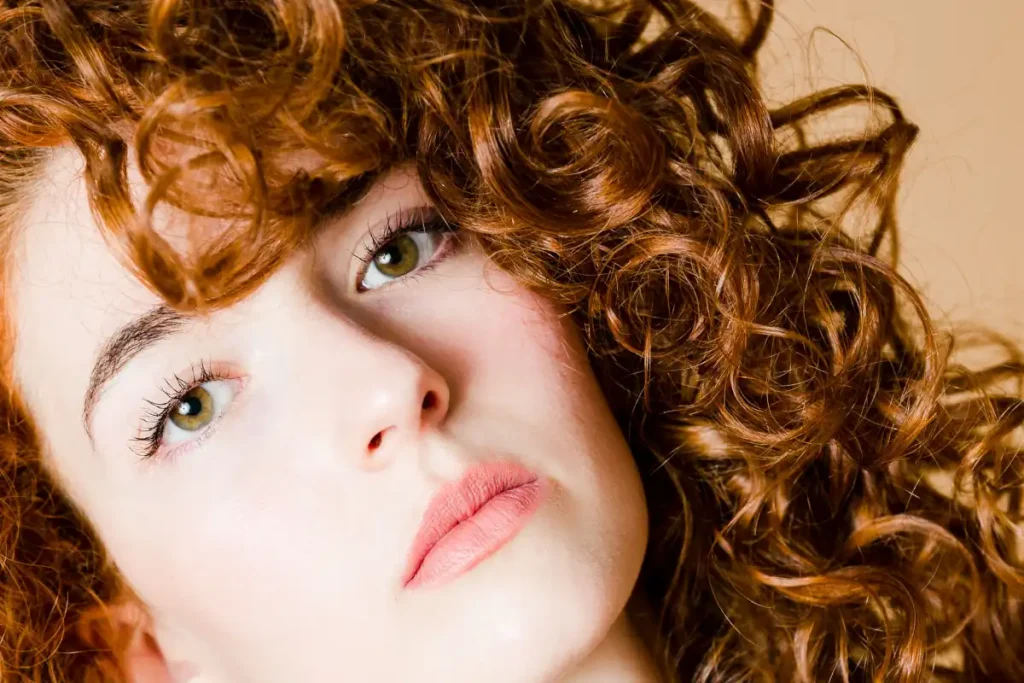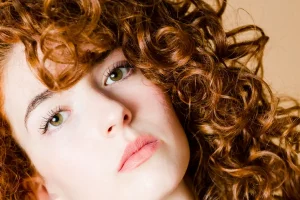
Blepharoplasty - Eyelid Intervention






Before and After Blepharoplasty at Aesophy Clinic

Blepharoplasty Price Malaga
| Procedure | Price |
|---|---|
| Upper Blepharoplasty | From: €1.600,00 |
| Lower Blepharoplasty | From: €2.000,00 |
| Complete Blepharoplasty | From: €2.500,00 |
| Intervention |
| Anesthetist |
| Preoperative |
| Necessary medication |
| All queries and reviews |
| 24-hour emergency telephone |
| What does the price include? |
Table of contents Blepharoplasty
Do you feel tired of looking tired and aged due to sagging eyelids? Are you looking for a solution to rejuvenate the appearance of your eyes and improve your overall appearance?
If so, you may want to consider blepharoplasty, a popular surgical procedure that can improve the appearance of your eyelids and rejuvenate your face.
La blepharoplasty It is a cosmetic surgery that consists of removing excess skin and fat from the eyelids, with the aim of rejuvenating the look and improving facial expression.
At Clínica Aesophy we are specialists in this eyelid intervention, which we perform with the maximum guarantees of safety and quality. Some of the main reasons why our patients choose blepharoplasty are:
– Correct the drooping of the upper eyelids, which can make vision difficult and give a tired or sad appearance.
– Eliminate fat bags from the lower eyelids, which cause puffiness and dark circles, and diminish the luminosity of the eyes.
– Reduce wrinkles and expression lines around the eyes, which become accentuated with the passage of time and exposure to the sun.
– Harmonize facial features and achieve a younger, fresher and more natural face.
If you want to know more about blepharoplasty, we invite you to contact with our clinic, where you will find detailed information about the procedure, results, postoperative care and possible complications. You can also request a free appointment with one of our plastic surgeons, who will advise you in a personalized way and answer all your questions.
What is blepharoplasty?
La blepharoplasty, also known as eyelid surgery, is a surgical procedure used to improve the appearance of the upper and lower eyelids. During blepharoplasty, excess skin, fat, and muscle are removed from the eyelids, which can help reduce the appearance of puffiness, bags, and wrinkles around the eyes. This procedure can be performed on both the upper and lower eyelids, or both.
La blepharoplasty It is a type of non-invasive aesthetic intervention that is performed on the upper eyelids and in the areas around the eyes in order to provide a rejuvenated image to the face.
Over time, the eyelids lose their elasticity, begin to accumulate skin and excess muscle, and end up looking droopy. In order to rejuvenate the look, micro incisions are made at specific points on the eyelids.
La Blepharoplasty is a term that encompasses a series of procedures aimed at aesthetic and functional improvement of the eyelids and the periocular region. Within aesthetic surgeries, it is one of the most demanded since the look is a very important part of our expression and that it is minimally invasive interventions that generally have a short recovery period.
types of blepharoplasty
There are several types of blepharoplasty that can be used to treat different areas and problems on the eyelids. Here is a description of the most common types of blepharoplasty:
Upper blepharoplasty
La upper blepharoplasty Focuses on the upper eyelids and is used to treat sagging skin and bags that can make the eyes look tired and aged. During surgery, an incision is made along the natural line of the upper eyelid to remove excess skin and fat. This helps smooth the appearance of the upper eyelids and rejuvenates the appearance of the eyes.
Lower blepharoplasty
La lower blepharoplasty it focuses on the lower eyelids and is used to treat bags under the eyes and fine wrinkles. During surgery, an incision is made under the lash line or inside the lower eyelid to remove excess fat and reduce the appearance of bags under the eyes. Skin can also be tightened to reduce the appearance of fine wrinkles around the eyes.
transconjunctival blepharoplasty
La transconjunctival blepharoplasty It is similar to lower blepharoplasty, but is performed without skin incisions. Instead, an incision is made on the inside of the lower eyelid to access the fat and bags under the eyes. This type of blepharoplasty is ideal for patients who have a minimal amount of sagging skin on the lower eyelids and only need to reduce the appearance of bags under the eyes.
complete blepharoplasty
La complete blepharoplasty It is a more extensive procedure that focuses on both the upper and lower eyelids. During surgery, incisions are made in the natural lines of the upper and lower eyelids to remove excess skin, fat, and muscle. This helps improve the overall appearance of the eyes and rejuvenates the overall facial appearance.
It is important to speak with one of our experienced plastic surgeons to determine which type of blepharoplasty is right for you, as each patient has different needs and goals.
Benefits of a Blepharoplasty intervention
La blepharoplasty It is a surgery that is performed on the upper and lower eyelids to correct aesthetic and functional problems in this area. Some of the benefits of a blepharoplasty procedure are described below:
- Improve Appearance: Blepharoplasty can help improve the appearance of the eyes by removing excess skin, fat, and/or muscle that can cause a tired or prematurely aged appearance. This can make the patient look younger and more alert.
- Improve vision: In some cases, excess skin on the upper eyelids can interfere with vision. Blepharoplasty can help correct this problem, improving the patient's vision.
- Reduce wrinkles: Blepharoplasty can also reduce the appearance of wrinkles and fine lines around the eyes, which can make the skin around the eyes appear smoother and more youthful.
- Improves self-esteem: Blepharoplasty can help improve a person's self-esteem and confidence, as it can correct a cosmetic problem that has been bothering them for a long time.
- Lasting Results: The results of blepharoplasty are usually long-lasting, as the surgery removes excess skin and fat from the eyelids, which does not grow back.
How Is The Blepharoplasty Operation Performed?
La blepharoplasty It is a simple outpatient operation with a relatively quick recovery. In fact, it is performed only with local anesthesia and sedation. Thanks to this, the patient will not notice anything during the process. On the day of the intervention, you must go to the clinic with a companion and half an hour before surgery, with the documentation -which the doctor will previously request- and the necessary preoperative tests.
In the operating room, the nursing staff will ensure that the patient is comfortable and calm. Then, anesthesia is applied, the constants are checked and the go-ahead is given to start the intervention.
The simplicity of the blepharoplasty It makes it a type of outpatient operation, which does not require admission by the patient. A simple blepharoplasty can last between 30 and 45 minutes, but if it is carried out in conjunction with a lower or upper blepharoplasty, or with a facelift, it can last up to 3 hours.
After the surgery, the patient will wait approximately one hour under observation, and will be ready to go home.
Blepharoplasty Before and After
It is a surgical procedure that can help rejuvenate the appearance of the eyes by removing excess skin and fat around the eyelids. Here are some phases before and after blepharoplasty surgery:
Before blepharoplasty, some people may have sagging skin on their upper eyelids that can make them look tired or aged.
After blepharoplasty, sagging skin has been eliminated and the eyes have a more awake and youthful appearance.
Another common concern before blepharoplasty is the appearance of bags under the eyes, which can make someone look tired or sad.
After blepharoplasty, bags under the eyes have been eliminated and the skin appears smoother and more youthful.
In some cases, blepharoplasty can also help improve the appearance of the lower eyelids by reducing wrinkles and puffiness.
After blepharoplasty, the eyes appear more youthful and alert, which can help improve a person's confidence and self-esteem.
It is important to note that the results of blepharoplasty can vary from person to person, and not all results may be the same. If you are interested in blepharoplasty, it is important to speak with an experienced plastic surgeon to discuss your options and determine if blepharoplasty is right for you.
Preoperative Blepharoplasty Care
Before undergoing a blepharoplasty, the patient must explain to the doctor what he hopes to achieve with the surgery. He must also take into account that Blepharoplasty significantly improves the appearance of your eyes, but it does not offer radical changes. Thus, doctor and patient must be aware of the expectations.
In the preoperative blepharoplasty, an ophthalmological examination is carried out to ensure that the patient has good eye health. It should also be known if the patient has any medical problems, allergies to medications or if they take medication regularly.
Post-Operative Blepharoplasty Care
After undergoing a blepharoplasty, it is important that you carefully follow your plastic surgeon's instructions to ensure a successful recovery. Here are some postoperative care that you should keep in mind:
Rest and wound care: After surgery, it is important that you rest and avoid any strenuous activity for at least a week. It's also important to keep wounds clean and dry and follow your plastic surgeon's instructions on how to care for them properly.
use ice: You may feel swelling and bruising in your eyes after surgery. To help reduce these side effects, it is recommended that you apply ice to your eyes for the first few days after surgery.
Take medications as prescribed: Your surgeon may prescribe medication to help control pain and swelling after surgery. It is important that you take these medications as prescribed to ensure a comfortable and pain-free recovery.
Avoid strenuous activities: During the first few weeks after surgery, it is important to avoid any strenuous activity, including exercise and weight lifting. It's also important to avoid any activity that may increase pressure in your eyes, such as bending over or leaning forward.
follow a healthy diet: A healthy diet can help speed up the recovery process after surgery. Be sure to eat nutrient-dense foods, especially protein and vitamins A and C, to help promote proper healing.
Protect your eyes from sunlight and wind: It is important to protect your eyes from sunlight and wind during the first weeks after surgery. Wear sunglasses and avoid being in areas with strong winds that can irritate your eyes.
Follow the instructions of your plastic surgeon: Every patient is different and will have different needs and recommendations after surgery. It is important that you carefully follow your plastic surgeon's instructions to ensure a safe and effective recovery.
It is important that you carefully follow your plastic surgeon's instructions after blepharoplasty to ensure a successful recovery.
With proper care and post-operative care, you can enjoy the results of your blepharoplasty and feel more confident and confident in your appearance.
Who Is The Best Candidate For Blepharoplasty Surgery?
Men and women seeking improvement of puffy upper eyelid or lower eyelid bags may be good candidates for Eyelid Surgery (Blepharoplasty). Just as there are different types of plastic surgery, patients should have realistic expectations and be in good physical health.
Recovery After Blepharoplasty Surgery
After Blepharoplasty Surgery swelling and bruising is common, which can be controlled with cold compresses and keeping the head elevated when lying down. The eyes may initially feel itchy, dry or sticky. The eye area will need to be cleaned regularly for a week and a half after surgery, and eye drops are recommended.
Any discomfort the patient experiences can be controlled with prescribed pain medication. Bruises at all sites will disappear in two to four weeks.
What are the possible risks and complications of blepharoplasty?
As with any surgical procedure, there are some potential risks and complications associated with blepharoplasty. Some of these include:
- Excessive bleeding during surgery
- Infection in the surgical area
- Allergic reaction to anesthesia
- Healing problems, including visible scars or keloids
- Asymmetry in the appearance of the eyes or eyelids after surgery
- Vision problems, such as double or blurred vision
- Eye dryness
What does the price of a blepharoplasty intervention at Clínica Aesophy include?
In the Aesophy Clinic, we offer a comprehensive service for the intervention of blepharoplasty, ensuring that our patients receive complete and personalized care. From the preoperative until postoperative reviews, including the anesthesia, own intervention, medication necessary, and a service emergencies available to guarantee your peace of mind. Additionally, we understand the importance of accessibility to our services, which is why we offer options for adapted to your needs. With us, you will receive exceptional care in every step of your procedure, because in Aesophy Clinic, everything is included for your well-being and satisfaction.Frequently asked questions Blepharoplasty
What is blepharoplasty and what is it for?
La blepharoplasty is a plastic surgery performed on the eyelids. Its purpose is improve the appearance of the upper and lower eyelids and/or improve vision in people who have excess skin obstructing the visual field. This intervention can have both aesthetic and functional purposes. Here I explain more in detail:
Aesthetic Purposes
- Improved Appearance: Blepharoplasty is used to treat excess skin, sagging skin, bags under the eyes, and drooping eyelids that often result from the aging process. Surgery can make the eyes and face look younger and more rested.
- Removal of Excess Skin: On the upper eyelids, excess skin that creates a sagging and tired appearance can be removed.
- Bag Reduction: In the lower eyelids, bags can be reduced and puffiness improved.
Functional Purposes
- Vision Improvement: For some people, blepharoplasty may be necessary to remove excess skin from the upper eyelids that obstructs vision.
- Comfort: Removing excess skin and fat can also increase comfort in the eye area.
Procedure
- Surgery: Blepharoplasty involves making incisions in the natural folds of the eyelids to remove skin and fat. These incisions are then closed with sutures.
- Anesthesia: Generally, it is performed under local anesthesia with sedation or under general anesthesia.
- Recovery: The recovery process may include bruising and swelling. Most people can return to normal activities within a couple of weeks.
Considerations
- Preoperative Consultations: It is important to have a complete medical evaluation and discuss expectations and possible risks with a qualified plastic surgeon.
- Risks and Complications: Like any surgery, blepharoplasty carries risks, such as infection, problems with healing, or changes in the sensation of the eyelids.
In summary, blepharoplasty is an effective surgery to improve the appearance of the eyelids and, in some cases, to improve visual functionality. However, as with any surgical procedure, it is essential to carefully consider the expectations and risks involved.
Who are ideal candidates for blepharoplasty?
- People with Visible Signs of Aging on the Eyelids:
- This includes excessive skin that causes drooping of the upper eyelids, bags under the eyes, and wrinkles or folds in the lower eyelids.
- People with Obstructed Vision:
- Individuals whose vision is partially obstructed by sagging upper eyelid skin.
- Good General Health:
- Ideal candidates should be in good general health, with no medical conditions that could complicate surgery or recovery.
- Non-Smoking:
- Smoking can negatively affect the healing process, so non-smokers or those willing to quit smoking before and after surgery are ideal candidates.
- Realistic Expectations:
- It is important to have realistic expectations about the results of surgery. A good candidate understands what blepharoplasty can and cannot achieve.
- No Serious Eye Conditions:
- Candidates should not have serious eye conditions that could complicate surgery, such as severe glaucoma or retinal detachment.
- People Seeking Aesthetic Improvements:
- Individuals seeking to rejuvenate the appearance of their eyes and face to look more rested and younger.
- Patients Committed to Postoperative Care:
- Candidates must be willing to follow post-operative care instructions and attend follow-up appointments.
What is the difference between upper and lower blepharoplasty?
Upper Blepharoplasty
- Objective: This surgery focuses on the upper eyelids. Its main goal is to remove excess skin and fat that can cause drooping eyelids and, in some cases, obstruct vision.
- Process: An incision is made in the natural crease of the upper eyelid. Through this incision, excess skin, fat, and in some cases, muscle is removed. The incision is then closed with fine sutures.
- Results: Results include a more open and rejuvenated appearance of the eyes, and in cases where vision was obstructed, an improvement in the visual field.
Lower Blepharoplasty
- Objective: This type of surgery focuses on the lower eyelids and is aimed at reducing bags under the eyes, removing excess skin and correcting lower eyelid drooping.
- Process: The incision can be made just under the lower eyelashes or inside the eyelid (transconjunctival). Excess fat is removed or relocated and, if necessary, excess skin is removed.
- Results: The results are usually a decrease in bags and wrinkles under the eyes, giving a younger and more rested appearance.
General considerations
- Candidates: Candidates for both types of blepharoplasty generally include people who have visible signs of aging in their eyelids, although upper blepharoplasty is often sought by those who experience visual obstruction.
- Recovery: Recovery for both procedures is similar, with some bruising and swelling that subsides over time.
- Choice of Procedure: The decision to perform upper or lower blepharoplasty, or both, depends on the patient's specific needs and goals.
What is the recovery process like after blepharoplasty?
Immediately after surgery
- Break: Resting with the head elevated is recommended to reduce swelling.
- Cold Compresses: Using cold compresses can help minimize swelling and bruising.
- Specific Instructions: Your surgeon's instructions for eye care should be followed, which may include cleaning and applying ointments.
First days
- Swelling and Bruising: It is normal to have swelling and bruising, which peaks in the first few days and then begins to subside.
- Blurry vision: There may be temporary blurred vision due to lubrication used during surgery or swelling.
- Minor Discomfort: Patients may experience some discomfort, which is usually controlled with medications recommended by the surgeon.
First week
- Review and Withdrawal of Points: If sutures that do not dissolve on their own were used, they are usually removed within a week.
- Reduction of Activities: It is recommended to avoid strenuous activities, including intense exercise, to avoid complications.
Several weeks
- Progressive Improvement: Most bruising and swelling should go away within a few weeks.
- Return to Normal Activities: Patients usually return to most normal activities after 10 to 14 days, although this can vary.
- Solar protection: It is important to protect your eyelids from the sun by wearing sunglasses and applying sunscreen to prevent pigmentation of bruises while they heal.
- Follow-up: Follow-up visits should be scheduled with the surgeon to evaluate the healing process.
Final results
- Visible Results: Final results are usually visible after several weeks, although it may take up to a year for the scars to fully mature.
What risks and possible complications does blepharoplasty entail?
- Hematoma or Bleeding:
- A common risk in any surgery, it can occur around the eye area.
- Infection:
- Although rare, there is a risk of infection at the surgery site.
- Reactions to Anesthesia:
- Some people may have adverse reactions to the anesthesia used during the procedure.
- Temporary Vision Problems:
- Blurred or double vision may occur temporarily after surgery due to swelling.
- Asymmetry in Healing or Results:
- There may be differences in the appearance or position of the eyelids after surgery.
- scars:
- Although blepharoplasty scars are usually well concealed, there is a risk of visible scars or changes in skin color.
- Dry eyes:
- Some patients may experience dry eyes after surgery, which is usually temporary.
- Difficulty Closing Eyes:
- In rare cases, excessive skin removal can make it difficult to completely close the eyes.
- Changes in the Sensation of the Eyelids:
- There may be numbness or changes in sensation in the eyelids that are usually temporary.
- Need for Revision Surgery:
- Some patients may require additional surgery to correct or improve results.
How long do the results of a blepharoplasty last?
- Longevity of Results:
- In general, the results of a blepharoplasty can last for many years. For many patients, the results can be virtually permanent, especially when it comes to removing excess skin on the upper eyelids.
- Factors Affecting Duration:
- The longevity of results can be affected by several factors, including the patient's genetics, lifestyle, and skin care. Factors such as sun exposure, smoking, and overall skin quality can influence how quickly signs of aging develop after surgery.
- Continuous Aging:
- Although blepharoplasty can provide a more youthful, rested appearance, it does not stop the natural aging process. Over time, the skin and tissues of your face will continue to change.
- Maintenance of Results:
- Proper skin care, a healthy diet, avoiding smoking, and protecting yourself from the sun can help maintain the results of surgery.
- Additional Surgeries:
- Some people choose to undergo additional procedures in the future to maintain or improve initial results.
- Individual Results:
- It is important to remember that results may vary from person to person. What is durable for one patient may be different for another.
Does blepharoplasty leave visible scars?
- Location of Incisions:
- In upper blepharoplasty, incisions are made along the natural crease of the eyelid, making scars less visible once they have healed.
- In lower blepharoplasty, the incisions are made just under the eyelashes or inside the eyelid (transconjunctival technique), which also helps to conceal scars.
- Incision Size:
- The incisions made during a blepharoplasty are relatively small, which contributes to less noticeable scars.
- Surgical techniques:
- Plastic surgeons use refined techniques to minimize the appearance of scars. This includes precise placement of sutures and meticulous care during incision closure.
- Healing Process:
- Healing varies by individual, but in general, blepharoplasty scars tend to mature and fade over time, becoming less noticeable.
- Postoperative Care:
- Following your surgeon's postoperative care instructions, such as avoiding sun exposure and not smoking, can improve healing and the appearance of scars.
- Additional Treatments:
- If necessary, there are additional treatments to improve the appearance of scars, such as laser therapies and special creams.
Does blepharoplasty leave visible scars?
- Location of Incisions:
- In upper blepharoplasty, incisions are made along the natural crease of the eyelid, making scars less visible once they have healed.
- In lower blepharoplasty, the incisions are made just under the eyelashes or inside the eyelid (transconjunctival technique), which also helps to conceal scars.
- Incision Size:
- The incisions made during a blepharoplasty are relatively small, which contributes to less noticeable scars.
- Surgical techniques:
- Plastic surgeons use refined techniques to minimize the appearance of scars. This includes precise placement of sutures and meticulous care during incision closure.
- Healing Process:
- Healing varies by individual, but in general, blepharoplasty scars tend to mature and fade over time, becoming less noticeable.
- Postoperative Care:
- Following your surgeon's postoperative care instructions, such as avoiding sun exposure and not smoking, can improve healing and the appearance of scars.
- Additional Treatments:
- If necessary, there are additional treatments to improve the appearance of scars, such as laser therapies and special creams.
Can blepharoplasty be combined with other aesthetic procedures?
- Facelift or Rhytidectomy:
- Combining a blepharoplasty with a facelift can offer more complete rejuvenation, addressing sagging and wrinkles not only in the eyelids, but also in other areas of the face.
- Eyebrow Lift:
- A brow lift along with blepharoplasty can improve the appearance of the forehead and the area around the eyes, especially if there are drooping eyebrows that contribute to a tired or sad appearance.
- Laser Resurfacing:
- Laser resurfacing treatments can improve skin texture and tone, reduce fine wrinkles and age spots, complementing the effects of blepharoplasty.
- Dermal Fillers:
- Dermal fillers can be used to restore lost volume in other areas of the face, such as the cheeks or lips, complementing the results of blepharoplasty.
- Chemical Peels:
- Chemical peels can improve skin quality, addressing issues such as uneven pigmentation or rough texture, which can enhance the results of eyelid surgery.
How should I prepare for blepharoplasty surgery?
Preoperative Consultation
- Medical Evaluation: A complete evaluation by your surgeon is essential, which will include a physical examination and a review of your medical history.
- Discuss Expectations: Talk to the surgeon about your expectations and desired results.
Changes in lifestyle
- Give up smoking: Smoking can negatively affect healing. It is recommended to stop smoking several weeks before and after surgery.
- Avoid certain medications: Some medications and supplements can increase the risk of bleeding. It is important to discuss with your doctor what medications you should avoid before surgery.
Planning for Surgery
- Prepare the Home for Recovery: Make sure you have everything you need for a comfortable recovery at home, such as cold compresses, medications, and easy-to-prepare foods.
- Arrange Transportation and Postoperative Care: You will need someone to drive you home after surgery and, preferably, help you during the first few days of recovery.
- Taking Time Off: Plan to have enough time away from work and other obligations for a stress-free recovery.
The Night Before and Day of Surgery
- Fasting Instructions: Generally, you will be asked to fast (do not eat or drink) for several hours before surgery.
- Clothing and Belongings: Wear comfortable clothing and avoid wearing jewelry or makeup on the day of surgery.
General health
- Maintain a Healthy Diet: Good nutrition can help in the healing process.
- Report Health Changes: If you experience any major changes in your health before surgery, such as an infection or a cold, tell your surgeon.
Is blepharoplasty performed under local or general anesthesia?
Local anesthesia
- Common use: It is often used for less invasive procedures or when only one eyelid (upper or lower) is being treated.
- Process: The area around the eyes becomes numb, but the patient remains awake. Sometimes a sedative may be given to help the patient relax.
- Recovery: Recovery is generally quicker and the patient can go home shortly after the procedure.
General anesthesia
- Common use: Preferred for more extensive procedures, such as a blepharoplasty on both eyelids or when combined with other facial procedures.
- Process: The patient is completely asleep during surgery.
- Recovery: It requires a period of postoperative observation to ensure that the patient fully recovers from the effects of anesthesia.
Choice of Type of Anesthesia
- Factors to Consider: They include the duration of the procedure, the patient's medical conditions, the patient's anxiety level, and the preferences of both the patient and the surgeon.
- Safety: Both options are safe when administered by a qualified anesthesiologist or medical professional with experience in anesthesia.






